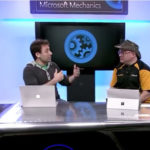In this podcast, the Radio Free HPC team looks at problems in the scientific software world. “There’s a bug in Python scripts that caused different results in identical routines run on different operating systems. As the guys discuss, it’s not a Python thing but a problem with the order in which files got read according to the operating system’s protocols. This impacts the sort order and thus the end results. The gang speculates on other causes of these types of problems and the fixes that should be employed.”
Tachyum Boots Linux on Universal Processor Chip
Today Tachyum announced it has successfully deployed the Linux OS on its Prodigy Universal Processor architecture, a foundation for 64-core, ultra-low power, high-performance processor. “Running an OS directly on the chip, without attaching to another host processor as an accelerator or other workaround, signals to the industry that Tachyum compiler and software is stable, mature, and approaching production-quality.”
Video: NVIDIA and Red Hat Simplify AI Development and Manageability
In this video, Tony Paikeday from NVIDIA describes how the DGX-1 for Red Hat Enterprise Linux is transforming enterprise computing with the power of Machine Learning. “Red Hat and NVIDIA have a solution with the certification of the NVIDIA DGX-1 for Red Hat Enterprise Linux. The combination enables enterprises to easily plug in and power up the AI supercomputer that has become the essential tool for AI innovators and researchers everywhere. And they can do so with a familiar operating system. In fact, 90 percent of Fortune 500 companies use Red Hat Enterprise Linux in their operations.”
New Types of Memory, their support in Linux, and how to use them via RDMA
Christoph Lameter from Jump Trading LLC gave this talk at the OpenFabrics Workshop. “Recently new types of memory have shown up like HBM (High Bandwidth Memory), Optane, 3DXpoint, NVDIMM, NVME and various “nonvolatile” types memory. This talk gives a brief rundown on what is available and gives some example on how the vendors enable the actual use of this memory in the operating system (f.e. DAX and filesystems) and then show how an application would make use of this memory. In particular then we will be looking at what considerations are important for the use of RDMA to those memory devices.”
Exploiting Modern Microarchitectures: Meltdown, Spectre, and other Attacks
Jon Masters from Red Hat gave this Keynote at FOSDEM 2018. “Recently disclosed vulnerabilities against modern high performance computer microarchitectures known as ‘Meltdown’ and ‘Spectre’ are among an emerging wave of hardware-focused attacks. This talk will describe several of these attacks, how they can be mitigated, and generally what we can do as an industry to bring performance without trading security.”
Job of the Week: HPC System Administrator at Embry-Riddle Aeronautical University
Embry-Riddle Aeronautical University in Daytona Beach is seeking a High Performance Computing System Administrator in our Job of the Week. “The HPC Specialist is responsible for technical systems management, administration, and support for the high-performance computing (HPC) cluster environments. This includes all configuration, authentication, networking, storage, interconnect, and software usage & installation of HPC Clusters. The position is highly technical and directly impacts the daily operational functions of the above environments.”
Video: Azure High Performance Computing
“Run your Windows and Linux HPC applications using high performance A8 and A9 compute instances on Azure, and take advantage of a backend network with MPI latency under 3 microseconds and non-blocking 32 Gbps throughput. This backend network includes remote direct memory access (RDMA) technology on Windows and Linux that enables parallel applications to scale to thousands of cores. Azure provides you with high memory and HPC-class CPUs to help you get results fast. Scale up and down based upon what you need and pay only for what you use to reduce costs.”
For HPC, Red Hat Offers Much More than just Linux
“The HPC Community demands performance, transparency, and value—exactly what Red Hat and open source offer. Red Hat is the standard choice for Linux in HPC clusterers worldwide. But it doesn’t stop there–our cloud, virtualization, storage, platform and service-oriented solutions bring real freedom and collaboration to federal, state, local, and academic programs. And Red Hat’s worldwide support, training and consulting services bring the power of open source to your agency. We are a part of a larger community working together to drive innovation.”
Mellanox Deploys Standard Linux Operating Systems over Ethernet Switches
Today Mellanox announced the availability of standard Linux kernel driver for the company Open Ethernet, Spectrum switch platforms. Developed within the large Linux community, the new driver enables standard Linux Operating Systems and off-the-shelf Linux-based applications to operate on the switch, including L2 and L3 switching. Open Ethernet provides data centers with the flexibility to choose the best hardware platform and the best software platform, resulting in optimized data center performance and higher return on investment.
Video: Brendan Gregg Looks at Tools & Methodologies for Linux System Performance
In this video from the 2016 Percona Data Performance Conference, Brendan Gregg, Senior Performance Architect from Netflix presents: Linux Systems Performance. “Systems performance provides a different perspective for analysis and tuning, and can help you find performance wins for your databases, applications, and the kernel. However, most of us are not performance or kernel engineers, […]













